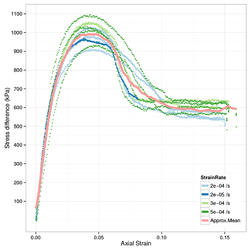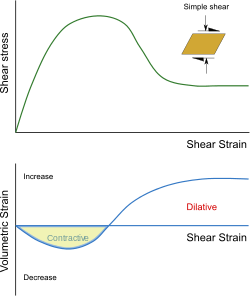Dilatancy (granular material)

Dilatancy is the volume change observed in granular materials when they are subjected to shear deformations.[1][2] This effect was first described scientifically by Osborne Reynolds in 1885/1886 [3][4] and is also known as Reynolds dilatancy.
Unlike most other solid materials, the tendency of a compacted granular material is to dilate (expand in volume) as it is sheared. This occurs because the grains in a compacted state are interlocking and therefore do not have the freedom to move around one another. When stressed, a lever motion occurs between neighboring grains, which produces a bulk expansion of the material. On the other hand, when a granular material starts in a very loose state it may initially compact instead of dilating under shear. A sample of a material is called dilative if its volume increases with increasing shear and contractive if the volume decreases with increasing shear.[5][6]
Dilatancy is a common feature of the soils and sands. Its effect can be seen when the wet sand around the foot of a person walking on beach appears to dry up. The deformation caused by the foot expands the sand under it and the water in the sand moves to fill the new space between the grains.
Dilatancy is also studied by geotechnical engineers, and is a part of the broader topic of soil mechanics.
Phenomenology

The phenomenon of dilatancy can be observed in a simple shear test on a sample of dense sand. In the initial stage of deformation, the volumetric strain decreases as the shear strain increases. But as the stress approaches its peak value, the volumetric strain starts to increase. After some more shear, the soil sample has a larger volume than when the test was started.
The amount of dilation depends strongly on the density of the soil. In general, the denser the soil the greater the amount of volume expansion under shear. It has also been observed that the angle of internal friction decreases as the effective normal stress is decreased.[7]
The relationship between dilation and internal friction is typically illustrated by the sawtooth model of dilatancy where the angle of dilation is analogous to the angle made by the teeth to the horizontal. Such a model can be used to infer that the observed friction angle is equal to the dilation angle plus the friction angle for zero dilation.
Why is dilatancy important?
Because of dilatancy, the angle of friction increases as the confinement increases until it reaches a peak value. After the peak strength of the soil is mobilized the angle of friction abruptly decreases. As a result, geotechnical engineering of slopes, footings, tunnels, and piles in such soils have to consider the potential decrease in strength after the soil strength reaches this peak value.
References
- ↑ Nedderman, R.M. (2005). Statics and kinematics of granular materials (Digitally printed 1st pbk. version. ed.). Cambridge, UK: Cambridge University Press. ISBN 0-521-01907-9.
- ↑ Pouliquen, Bruno Andreotti, Yoël Forterre, Olivier (2013). Granular media : between fluid and solid. Cambridge: Cambridge University Press. ISBN 9781107034792.
- ↑ Reynolds, Osborne (December 1885). "LVII. On the dilatancy of media composed of rigid particles in contact, with experimental illustrations". Philosophical Magazine Series 5. 20 (127): 469–481. doi:10.1080/14786448508627791.
- ↑ Reynolds, O., "Experiments showing dilatancy, a property of granular material, possibly connected with gravitation," Proc. Royal Institution of Great Britain, Read, February 12, 1886.
- ↑ Casagrande, A., Hirschfeld, R. C., & Poulos, S. J. (1964). Fourth Report: Investigation of Stress-Deformation and Strength Characteristics of Compacted Clays. HARVARD UNIV CAMBRIDGE MA SOIL MECHANICS LAB.
- ↑ Poulos, S. J. (1971). The stress-strain curves of soils. Geotechnical Engineers Incorporated. Chicago.
- ↑ Houlsby, G. T. How the dilatancy of soils affects their behaviour. University of Oxford, Department of Engineering Science, 1991.http://www.eng.ox.ac.uk/civil/publications/reports-1/ouel_1888_91.pdf